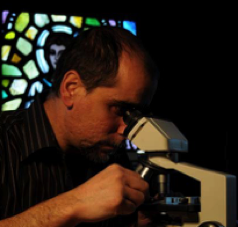During restoration, the paint on the glass is closely inspected for stability. Under a microscope, the paint is examined, and if it is stable, careful cleaning can proceed. The objective is to remove only the dirt and soot and to preserve the painted details that may have been obscured by the contaminants.
To the left is a detail photograph of a section from the South transept window designed by French artist, Eugéne Oudinot in 1877 located at Trinity Church in the City of Boston. The entire window was covered with black household paint during the 1950’s in an attempt to “defuse the light transmission” as the window was thought to be too bright. After closely examination, the paint was removed using cotton balls and warm water.


In the past, many buildings were heated with coal, which put a lot of soot into the air. In the case of churches, this combined with many years of smoke from burning candles. These, and other contaminants in the air, attach to the surface of the glass, diminishing the quantity and the quality of light transmission. This is particularly dramatic in plated windows (multiple layers of glass) where the contaminants have infiltrated between layers. Over the years this dirt absorbs moisture which attacks the paint, particularly if the paint is fragile and unstable.
Cleaning the accumulated grime and soot

If no fragile paint is found in a window, after dismantling each piece of glass is carefully cleaned with di-ionized water and a non-ionic surfactant detergent such as Orvus or Triton-XLN-80.

21 Highland Circle - Needham, Massachusetts 02494